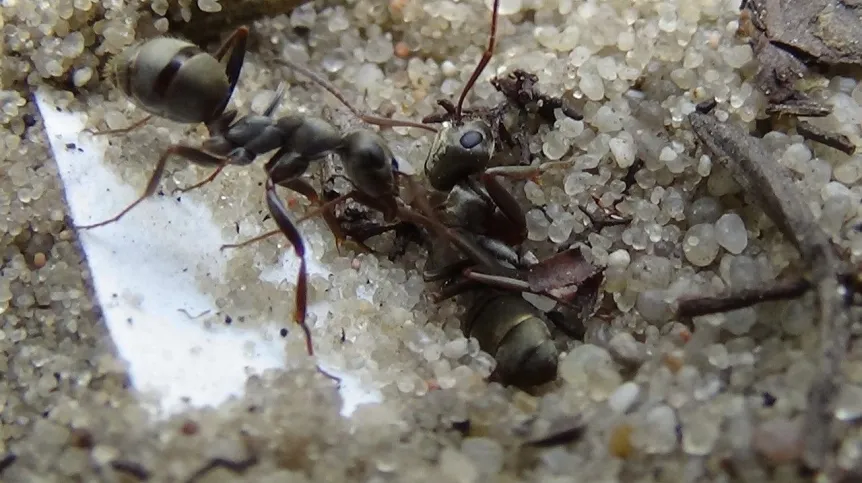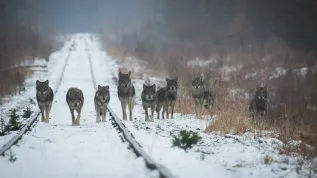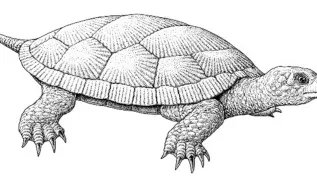
The longer the workers of a given species of ants live, the greater their tendency to rescue companions in need, Polish scientists have proven. Their results may be important for understanding social behaviours, especially those described as altruistic.
Scientists have long known that, in addition to humans, many other animal species also exhibit complex social behaviours, including rescue behaviours. They have been observed among monkeys, rodents, birds, dolphins, and even whales. 'They are quite common in vertebrates. However, among invertebrates, the only documented organisms capable of rescue behaviour are ants', says Filip Turza, PhD, from the Institute of Environmental Sciences of the Jagiellonian University in Kraków, the lead author of the study published in the journal Behavioural Ecology (https://doi.org/10.1093/beheco/arae104).
He explains that rescue behaviour is a situation in which one ant attempts to free a trapped, threatened by a predator or injured companion - a worker from the same colony. Such an action does not bring it direct benefits, and it is associated with risk - it can cost time, energy, or even life.
Despite this, ants can demonstrate astonishing determination. In natural conditions, they are capable of cutting spider webs to help an entangled companion, pull prey from the sand funnels of predatory antlion larvae, dig out an injured ant from underground, and also transport a wounded individual from the battlefield to the nest and then heal its wounds, for example by licking the damaged areas. In some species, there have even been cases of amputation of legs to prevent the spread of infection.
However, it turns out that such behaviours are not observed to the same extent in all ant species. Recent studies by scientists from Poland and Italy have shown that the key factor explaining this diversity may be the lifespan of workers.

Turza's team analyzed the behaviour of 14 species of ants found in Poland, belonging to different genera, tribes and subfamilies. Importantly, 11 of them had not been studied in this aspect before. The researchers' goal was to check whether the lifespan of workers affected their tendency to help their colleagues in dangerous situations.
The scientists collected over 10,000 ants: around 200 workers from each anthill; five colonies per species. Two types of experiments were conducted in the laboratory: one involved measuring the lifespan of workers in controlled conditions, the other simulated a dangerous situation - an ant was immobilized with a thin thread and partially covered with sand, so that another ant would have an opportunity to rescue it. In total, 3.5 thousand behavioural tests were performed and almost 300 hours of footage were recorded.

Their analysis showed that the reactions of the 'rescuers' were surprisingly complex. The ants took various actions: they contacted their trapped companion, dug up sand around it, pulled it by its legs, and even tried to bite through the thread. And the longer the workers of a given species lived, the more often and willingly they showed rescue behaviour. In short-lived species, help occurred sporadically or not at all.

Interestingly, the level of rescue behaviour did not depend on the evolutionary relationship between species. The author of the study emphasises that this means that the tendency to provide help appeared independently in different ant species. 'This suggests that this behaviour could have developed many times in the course of evolution', he adds.
When asked what the causes of the observed pattern, Turza replies that it is a simple cost-benefit calculation. If a worker ant lives for a short time, investing resources and energy in saving it is not very profitable from the point of view of the community. If it lives for a long time, it is worth fighting for it, because it has a chance to work longer for the good of all. 'It is logical from an evolutionary perspective: rescue is a costly and risky strategy, profitable only when the rescued individual has a long period of activity ahead of it. Previous studies have shown that if a colony lost five workers per day to spider webs, it would mean a loss of over 65 thousand seeds per year', the researcher reminds.

In the future, Turza would like to investigate what signals - chemical, sound and movement - the victim sends to stimulate the rescuer to act. He also plans to observe whether the ants' living environment can also affect the development of rescue behaviours.
'I am very curious about what exactly such a trapped worker secretes or how it behaves to arouse the desire to help in the other ant. These may be various types of pheromones, but they may also be specific movements. We also know that some species of ants can make sounds, thanks to a special stridulation organ (stridulation is making sounds by rubbing different parts of the body - ed. PAP). So the question arises whether it is about one of these factors or maybe a combination of all of them. There is still a lot to do in the context of research on ants', he concludes.
The research was carried out as part of the PRELUDIUM project of the Polish National Science Centre. Filip Turza is also a scholarship holder of the START programme of the Foundation for Polish Science (FNP).
PAP - Science in Poland, Katarzyna Czechowicz (PAP)
kap/ agt/ amac/













